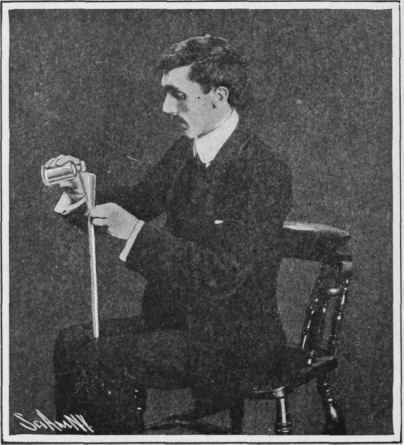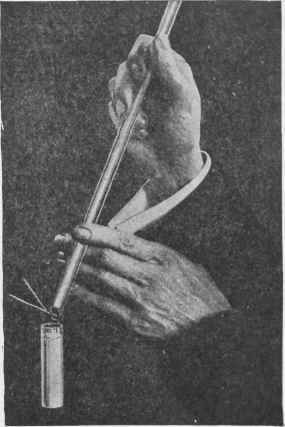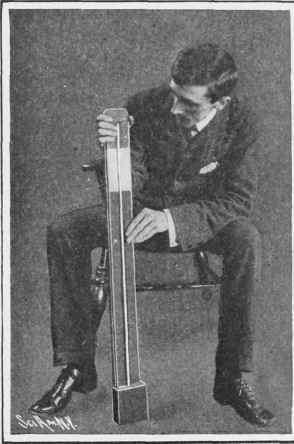A Home-Made Barometer
Description
This section is from the book "Handy Man's Workshop And Laboratory", by A. Russell Bond. Also available from Amazon: Handy Man's Workshop And Laboratory.
A Home-Made Barometer
As is well known, a barometer is nothing more than a contrivance for measuring the weight of the air. A glass tube closed at one end and filled with mercury, then immersed in a bath of the mineral without the admission of air. is an elementary form of the instrument. When the tube is upright, the column of quicksilver is seen to fall four or five inches, leaving a vacuum at the top. It will be evident that the height of the mercury in the tube responds to the variations in the weight of the atmosphere pressing on the bath of mercury. The relations of the movements of the "glass" to the weather are of course simple enough. When the atmosphere is heavy it causes the mercury column to rise, indicating fair weather; and conversely when the atmosphere is under low pressure the mercury column subsides, indicating the approach of a storm. For the construction of a home-made barometer, purchase about three-quarters of a pound of mercury, a glass . tube three feet in length and closed at one end, and a small glass receptacle four or five inches long. This should be large enough to take the end of the long glass tube, allowing a quarter of an inch or so all around. The wood necessary for the construction of the frame is likely to be found in almost any house. It is desirable that this work should be taken in hand in the first place. To make the frame take a board about three feet three inches long and four inches wide; make the whole nice and smooth. Now cut two strips of wood, say thirty inches long and one and a quarter inches in width. Screw these to the board far enough apart to allow the glass tube to be dropped in between them, at the same time taking care to place them four inches from the bottom of the board. Along the bottom of the board fasten a strip of wood sufficiently wide to support the glass receptacle. Add two pieces of wood to either side of the board, these to run up to where the two long strips terminate. In this way will be formed the three sides of a little box. A piece for the top of the box must have an archway scooped out in the center to allow for the passage of the tube. A square piece of thin wood may be cut to form the lid of the box. After applying some stain to give the wood a finish the frame is complete.

Fig. 165 - Filling the mercury tube.

Fig. 166 - Inserting the tube in the mercury receptacle.
The next matter for consideration is the filling of the small glass receptacle and the tube with mercury. In filling the tube a funnel formed out of a sheet of paper will be found useful. When the tube is full, place the finger over the orifice. Then invert the tube, and without admitting any air immerse the end in the mercury contained in the receptacle. This is likely to be rather a difficult undertaking, and perhaps the best way of all to accomplish it is to tie a piece of skin or leather very tightly over the upper end of the tube after it is full; then immerse, and finally cut away with a penknife the twine which hinds the skin. If this has been accomplished without letting in any air, the column of mercury will be observed to fall several inches. If atmospheric bubbles are to be seen working their way upward, the tube must be refilled.

Fig. 167 - The tube immersed in the mercury receptacle.

Fig. 168 - Fastening the tube to the frame.
The tube and receptacle must now be carefully removed to the case. The contrivance is best fixed into its position by looping wire round the tube in about four places, and twisting these tightly at the back. The scale is easily prepared. Consult a reliable barometer in quiet weather, and when this stands at 30.00, make a slight mark in the woodwork opposite the level of the mercury in the home-made article. On a piece of paper rule out your scale for the two sides of the glass to the extent of about four inches; dividing each into tenths. Put the central inch at 30.00, and number the inches up and down accordingly. Paste the slips of paper on either side of the tube, and cover the receptacle with the lid which has already been prepared, and the instrument is complete. The barometer should be kept in an upright position, and must never be hung where the sun will fall on it. It is not claimed that this contrivance will work with extraordinary accuracy, but if reasonable precautions are taken in its construction, the instrument should record the variations in pressure with fair reliability.
Continue to:


